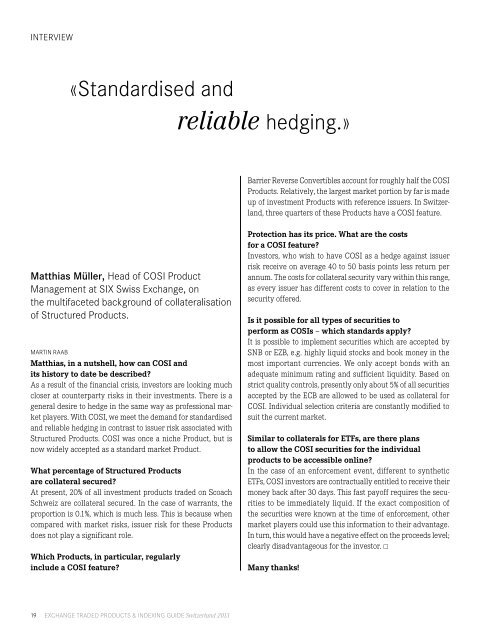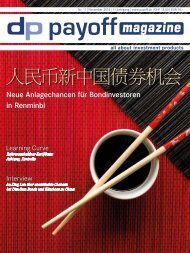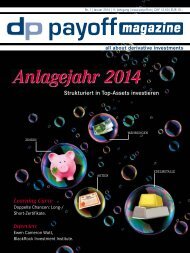Create successful ePaper yourself
Turn your PDF publications into a flip-book with our unique Google optimized e-Paper software.
InTErVIEW<br />
«standardised and<br />
reliable hedging.»<br />
Matthias Müller, head of cosI Product<br />
Management at sIx swiss <strong>Exchange</strong>, on<br />
the multifaceted background of collateralisation<br />
of structured <strong>Products</strong>.<br />
MarTIn raaB<br />
Matthias, in a nutshell, how can COSI and<br />
its history to date be described?<br />
As a result of the financial crisis, investors are looking much<br />
closer at counterparty risks in their investments. There is a<br />
general desire to hedge in the same way as professional market<br />
players. With COSI, we meet the demand for standardised<br />
and reliable hedging in contrast to issuer risk associated with<br />
Structured <strong>Products</strong>. COSI was once a niche Product, but is<br />
now widely accepted as a standard market Product.<br />
What percentage of Structured <strong>Products</strong><br />
are collateral secured?<br />
At present, 20% of all investment products traded on Scoach<br />
Schweiz are collateral secured. In the case of warrants, the<br />
proportion is 0.1%, which is much less. This is because when<br />
compared with market risks, issuer risk for these <strong>Products</strong><br />
does not play a significant role.<br />
Which <strong>Products</strong>, in particular, regularly<br />
include a COSI feature?<br />
19 ExchangE TradEd ProducTs & IndExIng guIdE <strong>Switzerland</strong> <strong>2013</strong><br />
Barrier Reverse Convertibles account for roughly half the COSI<br />
<strong>Products</strong>. Relatively, the largest market portion by far is made<br />
up of investment <strong>Products</strong> with reference issuers. In <strong>Switzerland</strong>,<br />
three quarters of these <strong>Products</strong> have a COSI feature.<br />
Protection has its price. What are the costs<br />
for a COSI feature?<br />
Investors, who wish to have COSI as a hedge against issuer<br />
risk receive on average 40 to 50 basis points less return per<br />
annum. The costs for collateral security vary within this range,<br />
as every issuer has different costs to cover in relation to the<br />
security offered.<br />
Is it possible for all types of securities to<br />
perform as COSIs – which standards apply?<br />
It is possible to implement securities which are accepted by<br />
SNB or EZB, e.g. highly liquid stocks and book money in the<br />
most important currencies. We only accept bonds with an<br />
adequate minimum rating and sufficient liquidity. Based on<br />
strict quality controls, presently only about 5% of all securities<br />
accepted by the ECB are allowed to be used as collateral for<br />
COSI. Individual selection criteria are constantly modified to<br />
suit the current market.<br />
Similar to collaterals for ETFs, are there plans<br />
to allow the COSI securities for the individual<br />
products to be accessible online?<br />
In the case of an enforcement event, different to synthetic<br />
ETFs, COSI investors are contractually entitled to receive their<br />
money back after 30 days. This fast payoff requires the securities<br />
to be immediately liquid. If the exact composition of<br />
the securities were known at the time of enforcement, other<br />
market players could use this information to their advantage.<br />
In turn, this would have a negative effect on the proceeds level;<br />
clearly disadvantageous for the investor. <br />
Many thanks!

















